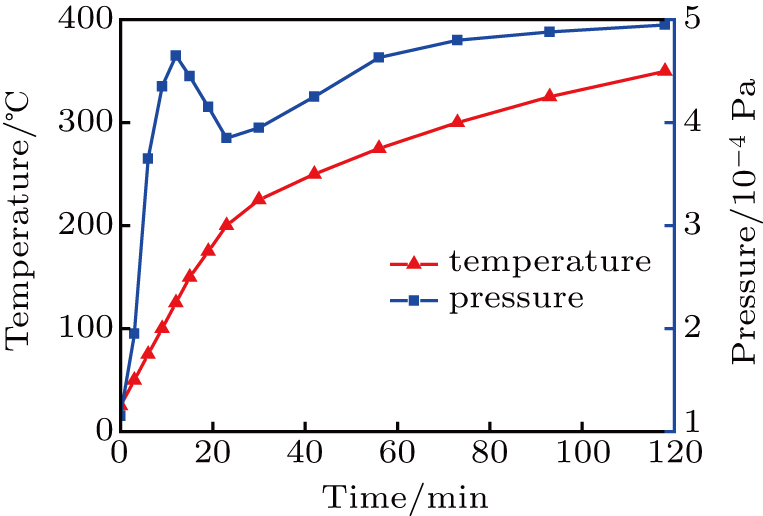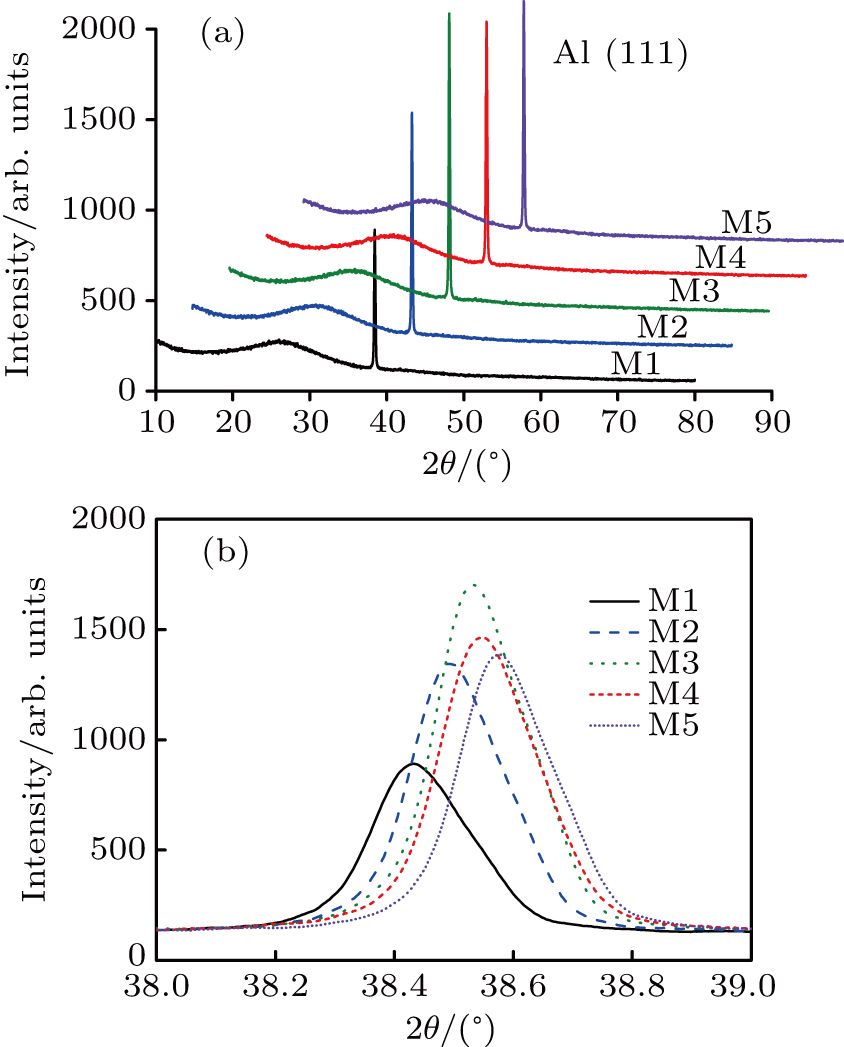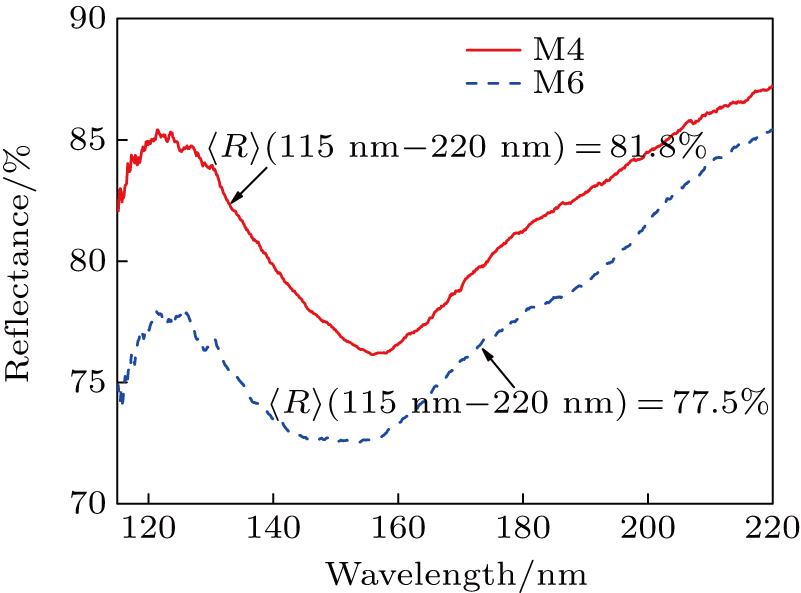Project supported by the West Light Foundation of the Chinese Academy of Sciences and the National Natural Science Foundation of China (Grant No. 61805247).
Project supported by the West Light Foundation of the Chinese Academy of Sciences and the National Natural Science Foundation of China (Grant No. 61805247).
† Corresponding author. E-mail:
Project supported by the West Light Foundation of the Chinese Academy of Sciences and the National Natural Science Foundation of China (Grant No. 61805247).
Both long-term environmental durability and high reflectance of protected-Al mirrors are of great importance for developing the optical instruments in the vacuum ultraviolet (VUV) applications. In this paper, the dependence of spectral property and environmental durability of MgF2 over-coated Al mirrors using a 3-step method on deposition temperature of the outermost MgF2 layer are investigated in detail. Optics (reflectance), structure (surface morphology and crystalline), and environmental durability (humidity test) are characterized and discussed. The results show that both optical and moisture-resistant properties of MgF2 over-coated Al mirrors are dependent on MgF2 deposition temperature, and the optimal deposition temperature for the outermost MgF2 layer should be between 250 °C and 300 °C for MgF2 over-coated Al mirrors to have both reasonably high reflectance in the VUV spectral range and high moisture resistance for long lifetime applications.
Optical coatings are indispensable in order to develop optical systems with the highest possible optical property. The best optical performance can be achieved by all-dielectric coatings. Due to the limited spectral band width of all-dielectric reflectivity mirrors, metal-based coatings are widely used in optical instruments. Among common mirror metals, including Al, Ag, Au, and Cu, Al is the only material choice in the vacuum ultraviolet (VUV) spectral range, due to its unique material properties such as a higher plasma frequency and no strong interband transitions in the interested wavelength range.[1] For this reason, Al coatings have been successfully applied to the Hubble Space Telescope (HST),[2] the Galaxy Evolution Explorer (GALEX),[3] and the FengYun III,[4] and will be used in the Large Ultraviolet Optical Infrared (LUVOIR)[5] and the Habitable Exoplanet Imaging Mission (HabEx).[6]
For the VUV applications, Al mirrors are strictly required to have high reflectance, low scattering, and high-environmental stability. The natural oxidation of Al severely degrades VUV reflectance owing to absorption loss,[7–10] hence a protected Al is normally used. For this reason, the fluoride materials with low intrinsic absorption, such us MgF2, AlF3, LiF, and Na5Al3F14, have been widely used as the protective coatings. Up to now, the researches on protected Al coatings in the VUV spectral range have focused on the preparations of Al and fluoride films. By combining different materials (Al/MgF2,[9,11,12] Al/AlF3,[3] Al/LiF,[11,12] Al/Na5Al3F14,[13] Al/LiF/AlF3,[14] and Al/AlF3/LiF/MgF2,[7] etc.) and by using different deposition techniques (such as thermal evaporation (TE),[7,9,15] ion beam sputtering,[16] atomic layer deposition,[1,17,18] etc.), their optical property and harsh environmental durability have been extensively investigated. It has been demonstrated that Al/MgF2 mirrors fabricated via TE present the best optical performance and environmental stability in the VUV spectral range. The resulting optical property of the mirror is strongly affected by the deposition conditions, such as purity of Al and MgF2 layer, low roughness and clean substrate, background and quality of vacuum, Al and MgF2 evaporation rate, and substrate temperature.
In the present work, TE is used to prepare MgF2 protected Al mirrors in VUV spectral range under different MgF2 deposition temperatures. The dependence of the optical performance, humidity sensitivity, and the microstructure-related properties (crystallization and surface morphology) of the mirrors on the MgF2 deposition temperature are comprehensively investigated by VUV spectrophotometer, x-ray diffraction (XRD), and atomic force microscope (AFM). The effect of substrate heating time and quality of vacuum pressure on the MgF2 over-coated Al are also evaluated.
All samples were prepared in a coating machine (ZZS800, Chengdu Nanguang Machinery Co. Ltd., China). This device was equipped with four thermal evaporators and two ceramic heaters. In the coating process a base pressure about 1.2 × 10−4 Pa was provided in the coating chamber with a cryopump set that ensured an oil-free environment for all depositions. The ultimate vacuum pressure was 8.0 × 10−5 Pa. In order to obtain a better vacuum and reduce the influence of water vapor on the properties of thin films, the vacuum coating machine with a polycold was a good choice. BK7 glasses (Φ 25.4 × 4 mm) with a root-mean-square surface roughness of approximately 0.5 nm were used as substrates and fixed above the evaporators. The distance between the evaporation source and substrate was about 450 mm. For deposition, the BK7 substrates were cleaned manually with alcohol and acetone. Tungsten-boat was used for the evaporation of high purity Al (99.999%), while MgF2 grains (Merck) was deposited by molybdenum-boat evaporation. The deposition rate and physical thickness for each of the thin films were controlled by a quartz-crystal monitor, which was fixed at the top center of the deposition chamber. Deposition rates of 10 nm/s and 0.2 nm/s were for Al and MgF2 layers, respectively. Deposition angles for both materials were smaller than 20°. A series of Al mirrors (each with a thickness of 80 nm) over-coated with a thin MgF2 layer was deposited by a 3-step coating process. The main step of the method had been well outlined and documented in other literatures.[9,11,15] In order to enhance the reflectance at 121.6 nm, the total thickness of MgF2 layer was set to be 25 nm. For the thin film design, optical constants of Al were obtained from the literature.[19] Parameters of MgF2 films were determined from spectrophotometric measurements as presented in Ref. [20]. The substrate temperature and the holding time were varied for preparing the second MgF2 layer. The deposition temperatures ranged from 25 °C to 350 °C. The holding time was set to be 0 and 120 min. The prepared sample types were summarized in Table
| Table 1. Overview of prepared sample types. . |
The reflectance for each of all Al mirrors was measured in the spectral range 115 nm–220 nm in steps of 0.1 nm and at an incident angle of 10° by using a high-precision ML6500 VUV spectrophotometer (Laser Zentrum Hannover, Germany). The nominal measurement accuracy of the VUV spectrophotometer is ±0.3% for the reflectance. In order to avoid the absorption of oxygen, moisture and hydro-carbon contamination, the spectrum was measured under vacuum environment with a pressure below 1.0 × 10−3 Pa. The surface morphology was characterized by using a Dimension 3100 atomic force microscope, performing in a tapping mode for imaging surface over scanning size of 5 μm square with 256 × 256 data points. Crystalline structure was evaluated with a Philips X’Pert-MRD x-ray diffraction. The start and end incident angle were 10° and 80°, respectively, in steps of 0.01°. Moreover, in order to study the humidity sensitivity of the as-deposited Al mirrors, samples were accelerated the ageing process in a custom humidity control chamber held at temperature of 50 °C and relative humidity of 95 ± 3% for 12 h, 24 h, and 36 h, respectively. After humidity experiments, the spectral performances of Al mirrors were measured and corresponding degradation of the reflectance was determined.
Figure
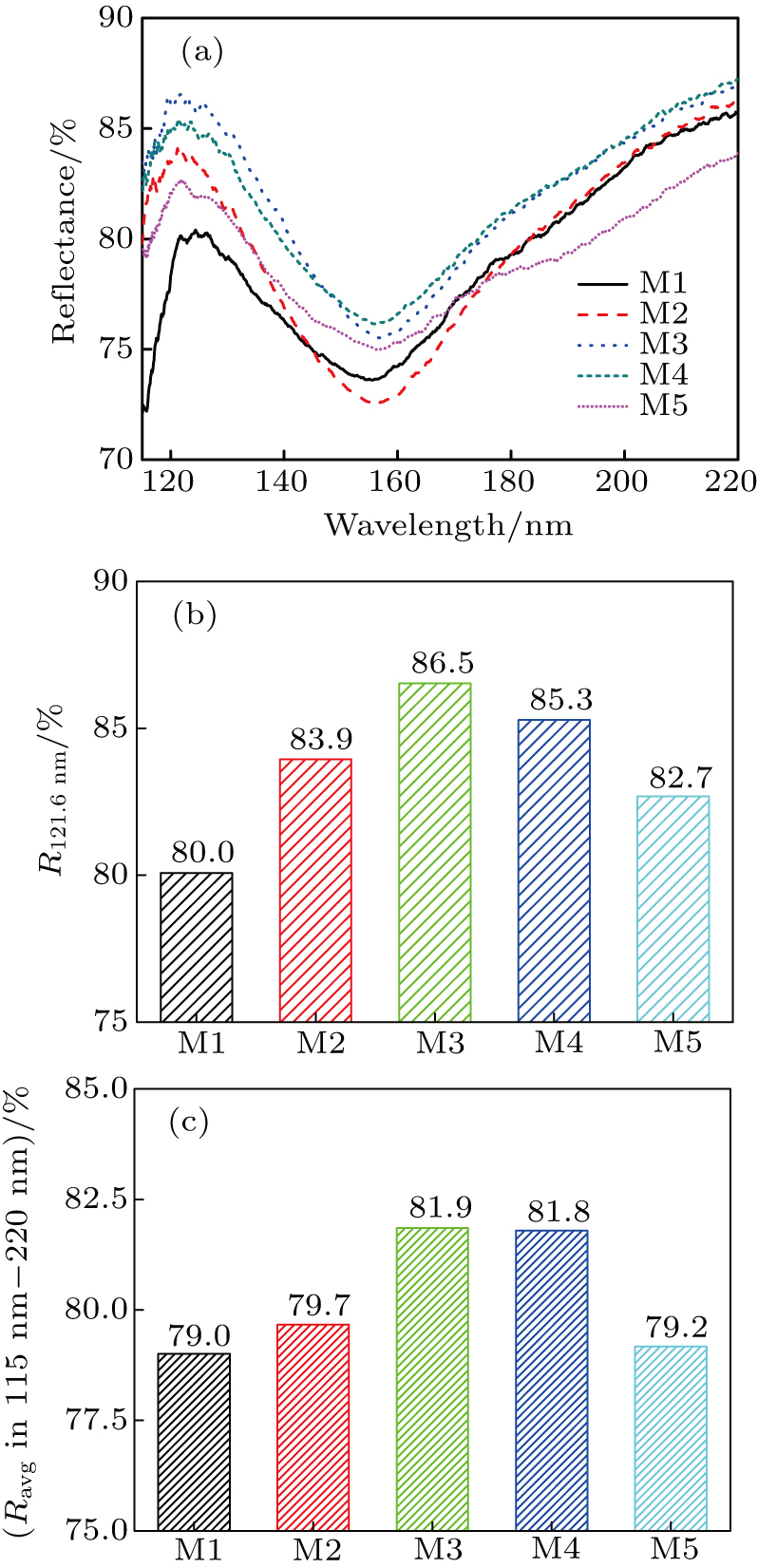 | Fig. 2. (a) Spectral performance, (b) reflectance (121.6 nm), and (c) average reflectance (115 nm–220 nm) of MgF2 over-coated Al mirrors with various substrate temperatures. |
Generally, the reflectance of MgF2 over-coated Al mirror in the VUV is influenced mainly by the absorptance and scatterring of the prepared layer system. Absorptance is due to the fact that both MgF2 and alumina have non-negligible absorption in the VUV region. As mentioned in Refs. [11], [21], and [22] a high substrate temperature is preferred to prepare the low-absorption MgF2 film. Obviously, the absorption of MgF2 film is not the main reason for reducing the reflectivity of Al mirrors prepared with a substrate temperature above 250 °C. On the other hand, the waiting period for the substrate to reach the expected temperature in between depositions of Al layer and MgF2 layer will cause the fresh Al surface to be oxidized and contaminated due to its interacting with gas released from the chamber wall. The influence of released gas on reflectivity of Al mirror will be discussed and experimentally verified below. Moreover, scatterring strongly depends on the structure and the surface quality of the layer. In order to comprehensively analyze the source of the discrepancy in optical performance of samples prepared at different deposition temperatures, characterizations of crystalline structure and surface topography are necessary.
Crystalline structures of the MgF2 over-coated Al mirrors deposited on BK7 substrates are revealed by XRD patterns, as presented in Fig.
Figure
Traditional TE technique is used to prepare MgF2 film with a columnar growth and a low material packing density. It provides a large free volume for accommodating the contaminations such as water. Condensed water not only leads the film to enhance the absorption and reduce the reflectance but also causes its lifetime to shorten. Therefore, it is necessary to improve the quality of the Al mirrors under harsh humidity conditions. The measured average reflectance and the relative reflectance degradation as a function of humidity test time of all Al mirrors are presented in Fig.
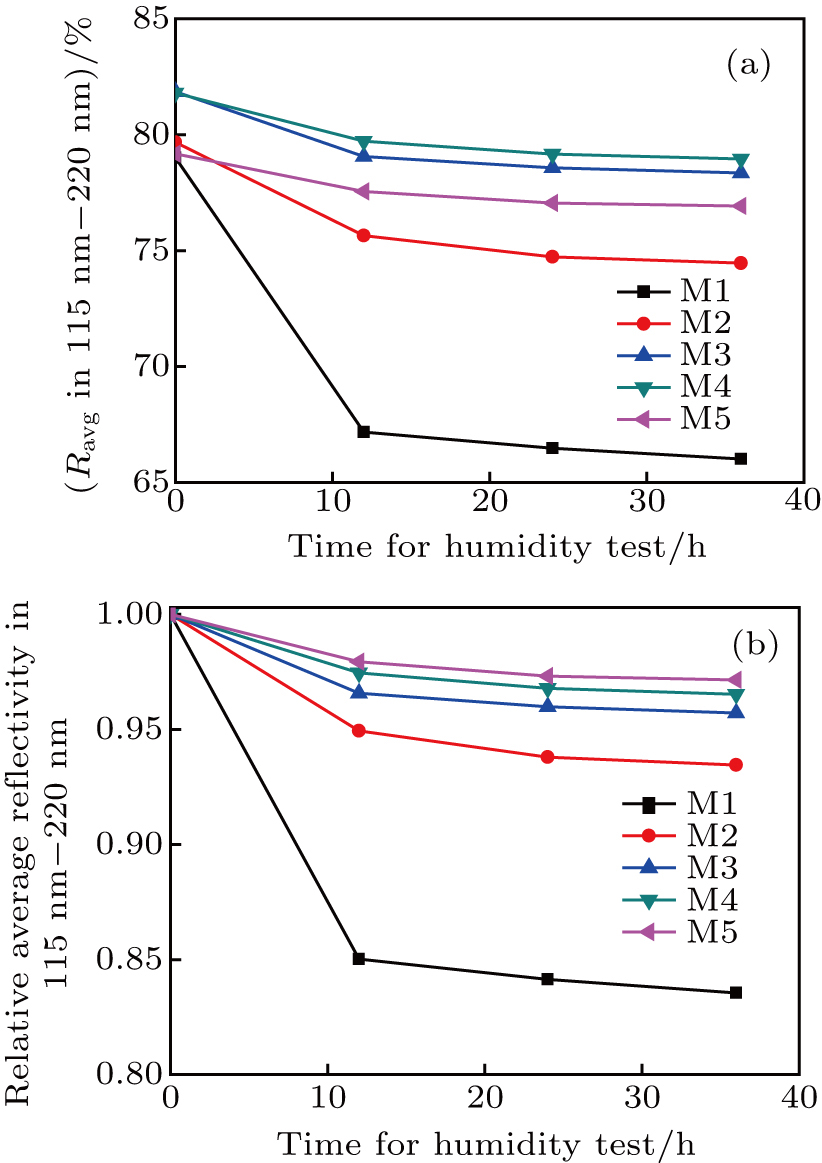 | Fig. 5. Plots of average reflectance (115 nm–220 nm) (a) and relative average reflectivity degradation (b) versus humidity test time. |
As already well documented in Ref. [11], the 3-step method for Al mirror preparation in VUV is based on the following considerations: firstly, Al layer grown with a high temperature is quickly contaminated by forming alumina and tends to rough surface morphology as crystal grain increases. Thus, the substrate at room temperature favors the fabrication of Al film. Secondly, MgF2 film deposited at high temperature produces a higher-density structure with lower absorption. Last but not least, between depositions of Al film and outermost dielectric layer, a very thin MgF2 layer is employed to cover the as-deposited Al film as soon as possible in order to protect it from forming oxidation and large crystal grain. Based on the previous experimental results, it is clear that neither the absorption of MgF2 layer nor scattering in coating system is the main cause for the decrease in optical property of Al mirror prepared at temperature above 250 °C. The remaining reason is that the 5-nm-thick MgF2 layer deposited by the second step may not completely prevent the fresh Al layer from being contaminated. As presented in Fig.
Based on a 3-step approach, experiments with MgF2 over-coated Al mirrors deposited at different substrate temperatures are analyzed and discussed. Spectrophotometer, AFM, and XRD are used to investigate the dependence of the optical and structural properties, and environmental durability on the deposition temperature. In this study, optical performances and environmental stabilities for Al mirrors prepared at substrate temperatures between 250 °C and 300 °C are improved significantly compared with those obtained from the ambient deposition technique. It has been shown that film properties of Al mirror may also be enhanced by diminishing the gas released from the chamber. Therefore, it is necessary to optimize the production machine and relevant components. These results would be of great importance for preparing the high-performance Al mirrors in the VUV applications.
| [1] | |
| [2] | |
| [3] | |
| [4] | |
| [5] | |
| [6] | |
| [7] | |
| [8] | |
| [9] | |
| [10] | |
| [11] | |
| [12] | |
| [13] | |
| [14] | |
| [15] | |
| [16] | |
| [17] | |
| [18] | |
| [19] | |
| [20] | |
| [21] | |
| [22] | |
| [23] |


